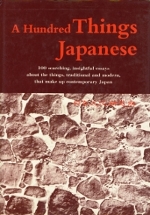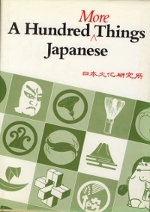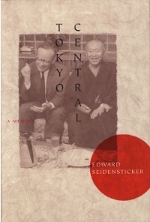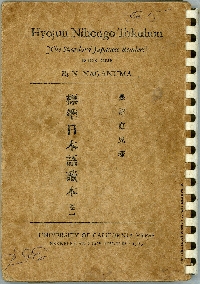September 29, 2009
Keene, Seidensticker et al.: Products of War, Commodities of Peace
Reviewed by William Wetherall
Focusing on recently published biographical works by the late Edward G. Seidensticker and Columbia University professor Donald Keene, William Wetherall evokes the personalities and the times of two great promoters of Japanese literature in the postwar era.
Wetherall’s articles on a variety of subjects are posted on the gateway to his websites.

Intrigued by its title and byline, I recently bought a bilingual book with the mixed-language title Discover Japan: Moshimoshi, sumimasen, dōmo by Donald Keene, E. G. Seidensticker, et al. The “et al.” includes forty other writers, translators, and scholars, most now aging but still living in Japan. Published in 1983 by Kodansha International, the book features fifty-four short articles in English with Japanese versions translated by Matsumoto Michihiro, whose name is billed larger than those of the two featured authors.
The pieces were selected from the two hundred articles in Discover Japan: Words, Customs and Concepts—Kodansha’s re-issue of the volumes originally known as A Hundred Things Japanese and A Hundred More Things, published in the mid-1970s by the Japan Culture Institute, one of several organizations—like the International Society for Educational Information and Kodansha International—founded after World War II to improve Japan’s image to the world.
Only the bilingual edition had a byline. But why mention only Keene and Seidensticker—who had only one article each—when some among the “et al.” had as many as five? Seidensticker might say, with a shrug and a grin, “We were more famous than Richie or Riggs.” And the name order? With a sigh and a smile: “Well, K comes before S in both English and Japanese.” And if Reischauer had written something? He might grimace, laugh and say, “It would have been ‘Reischauer, et al.’”

The drama of how Donald Keene (b. 1922) and Edward G. Seidensticker (1921–2007) became rival commodities, especially in Japan, emerges from a reading of their several autobiographical works. As preeminent “buffers” in the postwar realm of Japanese literature with a penchant for column writing, the two men made a classic good-cop, bad-cop team in their journalistic interrogations of life in Japan. Over the decades, Keene’s feelings about being asked if he can really read Japanese have softened from annoyance to disappointment. Seidensticker’s reactions to being asked if he liked “Japanese sushi” mellowed from sarcastic mischief to mirthful cynicism. Keene, ever humble about his efforts, is a better cop than he thinks, and Seidensticker was never as bad as he tried to be.

Keene has been more insistent that Japan is his country as much, if not more, than the United States, and that Japanese is not a foreign language for him. Seidensticker loved Japan no less but found more to complain about in the human condition generally. He had fewer inhibitions about baring his neuroses and exhibiting his fetishes. Keene, more selective and sparing, in On Familiar Terms, declares simply, “I am not making a confession” (p. 283).
In a Hundred Years
Edward Seidensticker knew where he stood in the pecking order of aliens honored by Japan for their service as volunteer or conscript “shock absorbers” between Japan and the outside world—buffers or ambassadors of mutual understanding, promoters of international goodwill and friendship. In Tokyo Central, he puts it plainly:
In 1975 I received the Order of the Rising Sun. It was only a Third Class decoration. Donald Keene had received the same Third Class decoration some time earlier. His was later raised to Second Class. First Class is reserved for people like Reischauer. I have never been raised from Third Class. (pp. 228–229)
Seidensticker was dogged by Keene’s greater fame and popularity in Japan. He wrote Tokyo Central while consulting and citing Keene’s On Familiar Terms. But Keene appears not to have returned the favor in Chronicles of My Life (Columbia University Press, 2008).

The different sensitivities of the two translator-scholars are clear from their autobiographies. In On Familiar Terms Keene gives several pages to his friendship with Yoshida Ken’ichi (1912–1977), who is standing or sitting next to him in two photographs. In Tokyo Central, Seidensticker introduces Yoshida as the literary critic son of Prime Minister Yoshida Shigeru, then dismisses him as “a friend who turned out not to be” and explains why: “One evening, for no reason that I could detect, he said substantially this: ‘There is a kind of American who is the most urbane, witty, and generally charming person in the world; but you are not it’” (pp. 148–49). Anticipating Yoshida’s response, yet curious to see if he would get an “honest answer,” Seidensticker says he asked who the American might be, but all he got was a “tense, high-pitched laugh.”
Before his achievement of publishing the first complete English translation of The Tale of Genji, Seidensticker worried about both the extent and longevity of his fame.
A gentleman from the Liberal Democratic Party with whom I had a conversation in the Suehiro knew the names of certain of my colleagues, but did not recognize mine when I informed him of it. It is not fun to have what small store of note one has accumulated dissipate itself so quickly. But I suppose it is some comfort to think that in a hundred years most of us will be forgotten. “It is a terrible thing, to seek to be remembered a hundred years,” Mr. Kawabata once remarked. In a thousand years not a half dozen people now alive will be remembered. Assuming, of course that there is anyone to remember. Or is it a comfort? (Diary entry for Monday, 31 May 1971; Genji Days, Kodansha International, 1977, p. 59)
If Remembered At All
Like Keene and many others, Seidensticker had trained as a language officer in preparation for service in the Pacific during World War II. After the war, in 1947, he completed a master’s degree in politics at Columbia. After passing the Foreign Service exam, he spent some time at Yale and Harvard, grooming himself for a State Department assignment as a language officer in Tokyo, where he worked in the Economic Section of GHQ/SCAP and then in the consulate until 1950.
Seidensticker learned that Edwin O. Reischauer (1910–1990), who had been one of his professors, “had not given ‘the Department’ a glowing report on my year at Harvard” (Tokyo Central, p. 44). Decades later he observed of Reischauer: “I liked him, but was by no means sure that I liked his performance as ambassador . . . [and] could not honestly share his views about Japan” (p. 177). He remarks how Reischauer was “sanctified by the Japanese” and his house in Boston “turned into a shrine to which busloads of Japanese pilgrims are taken” (p. 177). A four-page critique of Reischauer’s ambassadorship (1961–1966) is interspersed with comments recorded in his diary entries at the time from friends at the U.S. embassy in Tokyo.
For his part, Keene first met Reischauer thinking he might not like him. But in On Familiar Terms he writes, “I could not have been more mistaken” (p. 92). When Reischauer died, Keene realized they had embraced similar ideals and that he had unwittingly imitated the late ambassador. In a collection of articles he wrote in Japanese, he called Reischauer his “ikikata no moderu” [model in life] (Nihongo no bi [The Beauty of the Japanese Language], Chūō Kōron Sha, 1993, p. 105). Keene’s praise of Reischauer extended to Reischauer’s self-appointed role as a bridge between the United States and Japan. “I gradually came to realize that there was something of the missionary in me too, and if my work is remembered at all it will probably be because of the books addressed to the general public, not my attempts at ‘pure’ scholarship (On Familiar Terms, p. 94).
In 1964 Keene embarked on the writing of a new history of Japanese literature, to update, augment, and correct a history by W. G. Aston (1841–1911), which he had used as a student “often with irritation because of its old-fashioned judgments.” In On Familiar Terms, commenting on the “lukewarm or worse” reception to the first volume, which appeared in 1976 under the title World Within Walls: Japanese Literature of the Pre-Modern Era (1600–1867), he confesses to having doubts about it, “and, indeed, all of my writings” (pp. 269–72).
By 1991 he had published the other volumes in the series, but in the meantime, a new generation of specialists in Japanese literature had emerged, subjecting his work to its own standards of literary criticism. Commenting on the newer approaches to literature studies, he says, “When I read contemporary criticism, much of it phrased in language that I do not understand, I fear that I may have fallen hopelessly behind the times” (On Familiar Terms, p. 272). This sentiment is shared by many of Keene’s generational peers who “appreciated” the literature that some of the “next generation” preferred to “deconstruct.” The battle between the philologists and the postmodernists is still raging.
Prolific in Two Languages
Scholars and writers are generally aware that the shelf lives of their books may be shorter than their own expiration dates. Neither Keene nor Seidensticker seems to have entertained delusions about leaving a definitive work. Yet both wrote reams of manuscript, as though to ensure that at least one publication would survive them.
In addition to their numerous translations, histories, biographies, and linguistic aids, they authored about three dozen books of more personal commentary—most published only in Japanese, three in five of them by Keene—compiled mainly from the hundreds of articles they cranked out for newspapers and magazines in Japan during their annual sojourns in Tokyo, where both owned homes. Most of their Japanese works are “translations” first published in Japan. Many of the English editions are afterthoughts for other markets.
Keene’s Chronicles of My Life appeared first in Japanese as Watakushi to nijū-seiki no kuronikuru [Chronicles of Me and the Twentieth Century] (Chūō Kōron Sha, 2007). Both books contain the same articles Keene wrote in English for translation and publication in the Saturday morning edition of the Yomiuri Shimbun from 14 January to 23 December 2006, and for simultaneous publication in the Daily Yomiuri. I list the Yomiuri Shimbun first because I get the impression the column was intended to entice the paper’s 10-million subscribers to also take the 40,000-circulation English edition, known for its bilingual features. The articles were translated by Kakuchi Yukio (b. 1948), Keene’s principal translator for the past two decades.
On Familiar Terms has not been translated into Japanese, as many of the articles on which it was based had already been collected in Japanese publications. The most similar book is Kono hitosuji tsunagarite [Bound to This One Course] (Asahi Shimbun Sha, 1993), the title of which is from a Bashō poem that also appears in On Familiar Terms (p. 79). The Japanese book is a collection of articles that had run in the Sunday edition of the Asahi Evening News from 7 January 1990 to 9 February 1992. They had been translated into Japanese by Kanaseki Hisao (1918–1996), a longtime friend and colleague who became one of Keene’s main translators.
In On Familiar Terms Keene says, regarding another newspaper series: “I was enormously helped by the translator, Kanaseki Hisao, whom I had known for thirty years and who had once taught my courses at Columbia while I was on sabbatical leave” (p. 276). In Chronicles of My Life he says only: “Although I wrote my manuscript in English, it was well translated by my friend Kanaseki Hisao” (p. 152). This simplification of style and loss of detail invites my characterization of Chronicles (196 pages) as a somewhat updated but very diluted version of Terms (292 pages)—the result, I suspect, of Keene having to squeeze more of his life into fewer words in a fixed number of write-to-space installments, while keeping in mind the Yomiuri’s bilingual reader market.
Seidensticker handed his draft of Tokyo Central to Tetsuo Anzai (1933-2008), his principal translator, in 2000. The Japanese edition, poetically titled Nagareyuku hibi: Saidensutekkaa jiden [Passing Days: Seidensticker Autobiography], was published four years later (Jiji Tsūshin Sha, 2004). Anzai, a Shakespeare specialist, writes in his postscript that the Japanese version was supposed to have come out first, but illness delayed his work (p. 417).
Disciples and friends of Keene and Seidensticker have also been treading their publishing mills. J. Thomas Rimer, who had studied under Keene, gathered an impressive variety of his mentor’s memorabilia in The Blue-Eyed Tarōkaja: A Donald Keene Anthology (Columbia University Press, 1996)—which borrowed its title from, but is otherwise unrelated to, Keene’s biographical Aoi me no Tarōkaja [Blue-eyed Tarōkaja] (Chūō Kōron Sha, 1957). A bilingual spin-off called Mō hitotsu no bokoku, Nihon e [To Japan, Another Motherland] in Japanese and Living in Two Countries in English (Kodansha International, 1999), recycles from the Rimer book the articles Keene had written in English for translation in the Japanese edition of Reader’s Digest in the mid-1980s.
Rimer calls Aoi me no Tarōkaja the first book Keene published in Japan (p. viii), apparently believing Keene (On Familiar Terms, p. 181). In fact, it was Keene’s second, following by several months the Japanese translation of the first edition of one of his finest books, The Japanese Discovery of Europe: Honda Toshiaki and Other Discoverers, 1720–1798 (U.K. edition 1952, U.S. edition 1954, Japanese edition 1957). If I had to throw away all but two books by Keene, I would keep Rimer’s and the revised and expanded edition of The Japanese Discovery of Europe, first published in Japan in a totally new Japanese translation by Chūō Kōron Sha in 1968—a year before Stanford University Press brought out the newer English edition.
The year after Seidensticker’s death in July 2007, the Yushima woodcut artist Yamaguchi Tetsumi, who called his friend and neighbor “Saiden-san,” published Yanaka, hana to bochi [Yanaka, flowers and graves] (Misuzu Shobō, 2008) under Seidensticker’s byline. In his postscript, Yamaguchi describes the book as a collection of articles Seidensticker had written, some in Japanese, for Ueno, a local magazine (p. 202). In his blog, Yamaguchi affectionately remarks that his friend “was quite a trouble maker since his youth” and often quarreled with publishers; Yamaguchi’s devotion to Seidensticker was clearly shown when he brought the writer’s ashes from Tokyo to Honolulu (Yamaguchi’s “tyama-117” blog, 2008-06-12).
The Next Generation
If Seidensticker cultivated the image of an outlaw, Keene went out of his way to appear to be a good guy. Still hearing, it seems, the accusing tones of an unidentified voice, he enters this plea (On Familiar Terms, pp. 283–84). “I do not think I have ever ‘sold out’ to the Japanese in hopes of a reward or even merely of being liked; if I have made mistakes they were what my temperament dictated, not what I thought would bring me advantage.”
Elsewhere he wears the hat of a fundraiser: “I hope that the Japanese government, recognizing that Japan has no better friends abroad than the Japanologists, will enable young people to create a fourth, a fifth, and many subsequent generations” (The Blue-Eyed Tarōkaja, p. 81).
The academic and publishing worlds in which Keene has pursued his “missionary” goals are very political, and no one survives without bartering interests. From the very start of his engagement with Japan, Keene—more like Reischauer than Seidensticker in getting along, being accepted, and cultivating followers—has clearly leveraged his fame and popularity to bring advantage to himself and his causes.
Thanks to Keene’s diplomatic skills, learned while growing up and polished during his earliest sojourns in Japan, Columbia University has become the largest hub for Japanese literature studies outside Japan. The Donald Keene Center of Japanese Culture was established there in 1986. It is supported by endowments from several institutions with interests in promoting Japan—including Shinchosha Publishing, which provides fellowships and sponsors a professorship.
Judging from the Keene Center’s website, the center’s supporters are rather adept at scratching each other’s backs. Yet it is fitting that the Shincho Japanese literature chair created for Keene is now held by Haruo Shirane. Shortly after birth in Tokyo in 1950, Shirane accompanied his physicist father and pianist mother to the United States, where they eventually naturalized. Raised in English, he went to England to study English literature, but discovered Japanese literature in translation, and went on to get a doctorate at Columbia.
A protégé of both Seidensticker and Keene, Shirane is the chief editor of Traditional Japanese Literature: An Anthology, Beginnings to 1600 (University of Columbia Press, 2006) and Early Modern Japanese Literature: An Anthology, 1600-1900 (University of Columbia, 2002). These thick compendia have essentially replaced Keene’s epochal compilations, now half a century old—Anthology of Japanese Literature: from the Earliest Era to the Mid-nineteenth Century (Grove Press, 1955) and Modern Japanese Literature (Grove Press, 1956).
In the caption to a photograph in Tokyo Central, Seidensticker describes Shirane as “one of my most gifted students” (facing p. 59). Keene and Shirane were featured speakers at a February 2008 event held at Columbia University called “Edward Seidensticker (1918–2007): A Celebration of Lifetime Achievement in Japanese Literary Studies.”
Japanese Language School

Even before the Russo-Japanese War of 1904–1905, Japanese had become a strategic language for the United States. By the end of the nineteenth century, the U.S. had purchased Alaska, annexed the Hawaiian islands, and also nationalized the Philippine Islands. Shortly after Japan’s victory over Russia, the U.S. government set up a three-year language training program in Tokyo for foreign service officers and U.S. Navy personnel, out of which came the Hyojun Nihongo Tokuhon (The Standard Japanese Readers) by Naoe Naganuma, who had became the school’s chief instructor.
The school was pulled out of Tokyo in 1940 as diplomatic relations grew tense. After trial relocations at Harvard University and the University of California at Berkeley, Berkeley became its new home. In June 1942, however, the school, called the U.S. Navy Japanese Language School (JLS), moved to the University of Colorado in Boulder, as most of its instructors had been declared “enemy aliens” and, had they stayed, would have been interned in relocation centers outside the West Coast military zone.
Keene gives six pages in On Familiar Terms to his experiences at JLS at Berkeley, where his class matriculated (pp. 14–19). He makes no mention of the fact that his class moved with the school to Boulder and graduated there. At the time of the move, Seidensticker was working at the library of the University of Colorado, his alma mater. He would never have studied Japanese had JLS not moved to Boulder. In Tokyo Central he expresses “astonishment” that Keene failed to mention “this event of such major importance to me [which] seems to have meant nothing at all to him”—and that “neither Boulder nor Colorado is in the index” (p. 19). Keene, as though he had never read Tokyo Central, retells in Chronicles of My Life essentially the same story he told in On Familiar Terms—again with nary a word about Boulder or Colorado (pp. 31–35).
Yet Keene could not have forgotten the move to Boulder. The Interpreter—the newsletter of The Japanese Language School Project at the Archives, University of Colorado at Boulder Libraries—carries a letter from “Donald Keene (JLS 1943)” that begins: “I am sending you some of my official papers as a naval officer. They are extremely boring, but perhaps they may be of use if anyone is interested in tracking where language officers went” (No. 68, 1 October 2003). An earlier issue reported that Seidensticker had begun depositing his papers in the library archives (No. 21, 1 March 2001).
Connecting the Dots
Truth is not something one expects of an autobiography. Honesty is enough. And both Keene and Seidensticker are scrupulously honest in their quests to make entertaining sense of their lives as they age, alone, in their different public and private worlds. Autobiographies open journals and scrapbooks, drop names of friends and foes and famous others, disarm critics, set records straight, wax nostalgic and ideological, crack some private doors, conceal others. All of Keene’s and Seidensticker’s more personal commentary do one, some, or all of the above. But plunging into their books about themselves and Japan is to enter a bilingual hall of mirrors, some warped or broken, others attached to windcocks. A few stories change from one book or edition to the next, and a version in one language may be rephrased or censored in the other. And neither writer is an exception to the rule that authors should not be taken at their word, especially when reflecting on their own lives.
Keene grinds fewer old axes and is less gossipy, but depends on a faulty memory unaided by a diary. Seidensticker, consulting his diaries, thrives on repeating what he recorded others had told him, and is more anxious to settle old accounts. Although both wrote compulsively, Seidensticker’s stories have more narrative bite than Keene’s, more vicarious thrills per pound of pulp through tabloidesque exposé of the “nastiness” (Tokyo Central, p. 185) he witnessed behind the polite facade of life and academia.
Someone who never met these remarkable men might want to read their personal commentary in order to understand the ordinary human flaws of two individuals who seem, by their many contributions to the postwar development of Japanese literature in English, to be superhuman. For the present generation, their autobiographies are a bridge to a period when there were no laptops or cell phones, no on-line linguistic and bibliographic aids, no half-day trans-Pacific flights, and no college courses on manga.
Anyone who has learned Japanese in a classroom, at least in North America, or has studied anything about Japan in English anywhere, stands on the shoulders of luminaries like Keene and Seidensticker—or others who graduated from JLS or other such schools, or who benefited from government-sponsored programs established in the name of national defense or international relations—or on the shoulders of their children or grandchildren. Missionary roots also tangle with the lines that connect the historical dots of conflict and commerce between nations. Those of lesser stature who have crossed fleeting paths with such giants live in the shadows of their reflected glory, and sneak bits of their own stories into the legends.
Originally published in the SWET Newsletter, No. 121 (November 2008), pp. 12–23.
